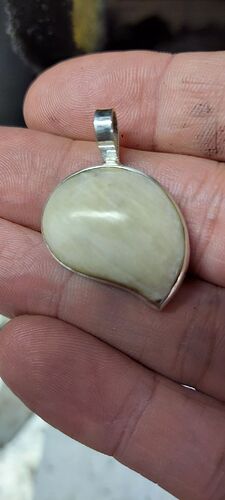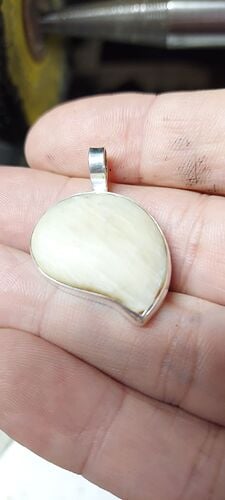Hey everyone. I ran into an unusual repair problem today resetting and polishing what I think is vegetable ivory.
I needed to replace a broken off bail on a silver pendant, so I carefully lifted up the bezel, took out the gem, and reset it. repolishing the gem was part of the job as well.
The only problem was that the gem is so soft that after polishing and cleaning that even rubbing off dust with a paper towel leaves scratches.
There was some sort of clear substance on the gem at some point because you could see the remnants around the side when I pulled out the gem from the bezel.
So for those who work with tanga nut/ vegetable ivory. What do you use to coat it with? Or do I not have vegetable ivory?
Thank you in advance for your advice.
From the description, it’s hard to say what you’ve got, except it’s something soft that sounds like it was glued into the setting. A close-up picture would help.
I will take a picture and post it on Sunday. It was definitely bezel set. There was no glue in the setting at all.
I don’t know what “Vegetable Ivory “ is, but Targa nut is not soft. In fact, it’s quite hard. It takes a good polish on its own. No need for something on top.
Real ivory is softer than targa nut, but will not scratch with a paper towel.
Here are 2 views of the piece with different lights. Was I far off when I assumed it was tanga nut?
I also have some natural ivory to use as samples to teach with (An old piano key), and it is definitely not animal ivory as far as I can tell.
This does not look like the targa nut that I have.
Maybe elk tooth? People out west use it a lot. This is just a guess.
The elks tooth is referred to as a bugle tooth. It is the only one of all of their teeth that is ivory. Our teeth are not ivory. The tooth is bigger than ours but it is not that big. The necklace shown with the supposed ivory is much larger than a bugle tooth. The jeweler I worked for in Park City Utah made many rings out of bugle teeth so I saw a lot of them.
the mystery continues! i love it!
julie
The shape resembles a tagua nut’s but the ones I’ve worked with didn’t have those mottled stripes seen in the top image. That’s more characteristic of bone. The color of my tagua nuts was quite even and consistent throughout.
Have you tested it with a hot point?
I have not. I will do it later at the lowest point so it is not obvious. Thanks for the suggestion.
I’ve carved quite a bit of tangua nut, and it is very hard. It certainly doesn’t scratch that easily. It’s really similar to ivory it that regard. Also, it looks like your piece has some slightly translucent areas; everything I carved was opaque. The color isn’t quite right either, it’s usually the color of aged ivory and it continues to darken as it’s exposed to air. I might have said that perhaps it was coated with something to keep that from happening, if the color and the translucency were different.
I’m wondering if it’s a soft stone like some kind of calcite. It doesn’t look too much like plastic. Is it cold to the touch? Can you get an SG on it? Or an RI? Is it biaxial? Too many variables out there to determine from just a photo.
Edit: see the picture next to my name; the head is tangua nut. Some of it is considerably lighter than this example, but it gives you an idea of what I’m talking about.

